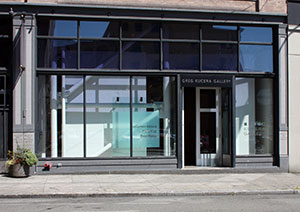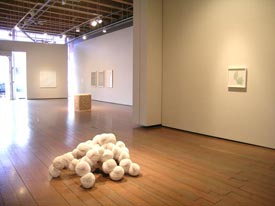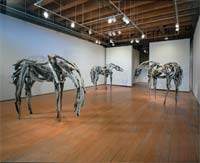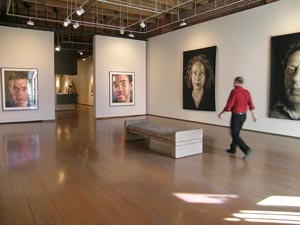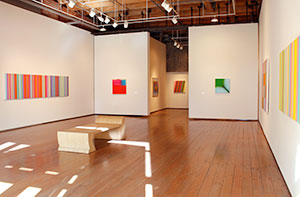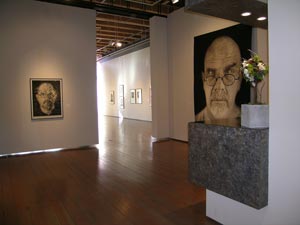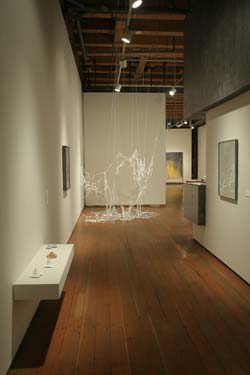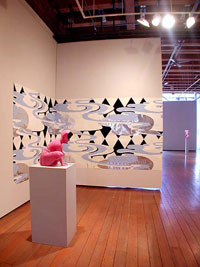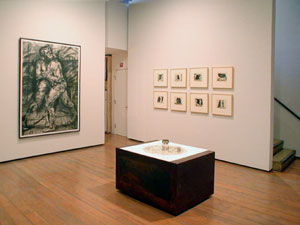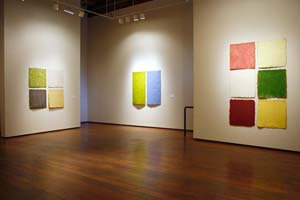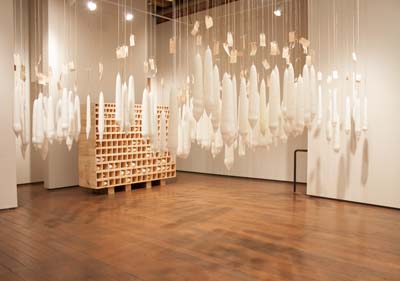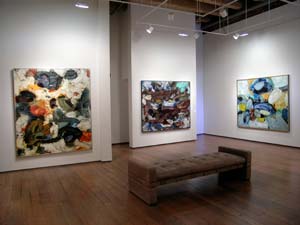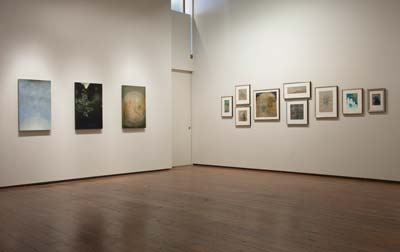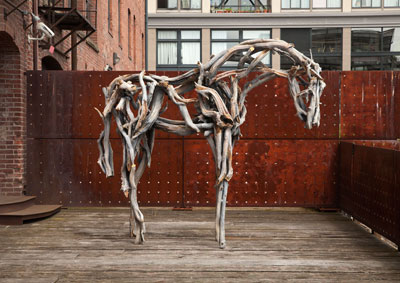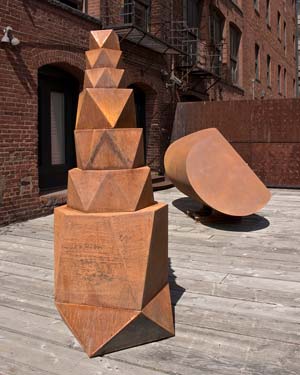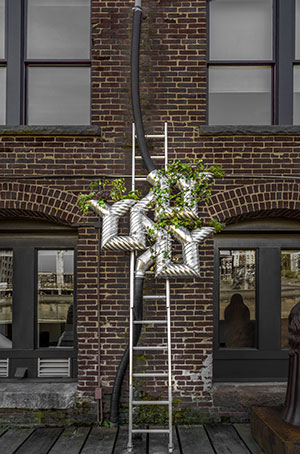Installation Views
A brief history of the gallery
Opening in 1983, the Greg Kucera Gallery made a modest introduction to the Seattle art scene. The only mention of it in the press was a three line paragraph at the end of an arts column in The Seattle Times.
Our first space was a dilapidated storefront of about 2,000 square feet in the Corona Hotel, a Samis Land Company building on Second Avenue. Our rent then was $350 per month! We added another 1,500 square feet a few years later. Within a few years, Gallery Frames, my mate Larry Yocom's business, moved out of our house and into a small space also near Second and James.
The Gallery began with a modest group show of artists which included established NW artists such as Alden Mason, Gene Gentry McMahon, Karin Helmich and John F. Koenig. A number of younger artists were quickly added including Mark Calderon, Michael Ehle, Jody Isaacson, Ross Palmer Beecher, and Ed Wicklander. We then began working with Roger Shimomura, an already established artist who began his career in Seattle. The gallery also soon began to show prints and works on paper by Robert Motherwell, Helen Frankenthaler, Richard Diebenkorn, Jim Dine and artists making prints with ULAE, including Jasper Johns, Robert Rauschenberg, Terry Winters and Elizabeth Murray.
For the first decade the gallery exhibitions rotated between emerging regional artists shown alongside emerging artists from New York or elsewhere such as Kiki Smith, Darren Waterston or Cheryl Laemmle. We also created a series of exhibitions devoted to internationally known artists like Susan Rothenberg, Roy Lichtenstein, Mimmo Paladino and David Hockney. It was my intention to create a context for printmaking alongside other forms of expression, such as drawings and paintings, by these artists. We worked with new editions coming from major printmaking studios such as Gemini G.E.L., PACE Editions, and Crown Point Press.
We began doing art fairs in 1985 with the Chicago Art Fair and then the Los Angeles Art Fair in 1986. We added occasional art fairs in San Francisco and New York as opportunities arose. In each of these fairs we showed the mixture of artists from the gallery's stable as well as a cross section of our current inventory.
Through the 1980s we showed prints by well-known artists, riding the crest of interest in contemporary artists and their prints. The gallery began to acquire inventory as the market for this material heated up. By the time it peaked in 1990 we had sold an amazing volume of prints by artists such as Stella, Motherwell, Diebenkorn, Rothenberg and Frankenthaler. As the market for this work swelled the print prices increased exponentially and the gallery's print inventory became a significant asset and a source of constant revenue.
The gallery began a series of politically themed exhibitions in 1989 with "Taboo," a look at the momentarily incendiary artworks by Andres Serrano, Robert Mapplethorpe, Sally Mann and others. This was followed over the next few years by "God & Country" and "This Is My Body" and "SEX" and "Bad Politics," all of which examined other aspects of contemporary political art. These exhibitions garnered the gallery attention in many different arenas. We also began to do political fundraisers for national causes and benefit exhibitions for groups such as Reflex Magazine, Artist Trust, and COCA.
Nationally known artists, dealers and collectors who had become aware of the gallery through art fairs and my business trip travels, now saw the gallery in a less “regional” context. We found that we suddenly had access to a different group of increasingly more important artists.
In the late 1980s and early 1990s we began to work with mid-career nationally known artists such as Deborah Butterfield, John Buck, Jennifer Bartlett, Robert Colescott, Mark Lere and Jane Hammond. Everything changed. Now we were showing a significant roster of well-known artists, emerging artists and local talent, examining the political motivations and cultural attitudes of our world.
In the early to mid-1990s the gallery lost several of the artists who had long been associated here such as John Koenig, Francis Celentano, Alden Mason, Ken Kelly and Jeffry Mitchell. This changed the gallery - in the long run, for the better - allowing for a newly shifted focus.
We continued to open up the field of artists we would work with, taking on Anne Appleby and doing significant early shows for Ann Hamilton, Kara Walker, Lesley Dill, and Kerry James Marshall. We also did shows in the late 1990s for Bill Traylor and Morris Graves as a way of broadening the scope to include these older, venerable or deceased artists.
By the mid 1990s, Jena Scott, an associate for over a dozen years, began work on our website - and slowly bringing the gallery into the late 20th century knowing that the 21st was imminent. Jena has single-handedly - and single-mindedly - been the driving force behind the creation, design and maintenance of the website as her time in the Gallery permits. Her prescient interest and faith in the internet has paid off for all of us in innumerable and significant ways.
In 1998, the gallery acquired a condominium space at Third and Main in the Lofts Building, and then the adjacent space in 2002. Purchasing these two storefront locations of about 7,000 square feet had many positive effects. Firstly, it secured the gallery financially by giving us a real estate asset while freeing us from being "rent slaves" and gave us equity. The mortgages turned out to be significantly smaller than the rent would be for this space or a similar space. We also have the advantage of an outdoor sculpture area and a much greater variety of exhibition space and storage room here. David DiMarco designed the space and gave us everything we wanted and needed.
In the intervening years, we have added mid-career artists such as Alice Wheeler, Cris Bruch, Jeff Simmons, Mark Newport, Tim Roda, Jack Daws, Margie Livingston, Chris Engman, Victoria Haven, Marie Watt, Dan Webb, and Darren Waterston. We took on representation of senior artists such as Sherry Markovitz, Gregory Blackstock, Michael Knutson, Norman Lundin, Peter Millett, Susan Skilling, Whiting Tennis, and Claudia Fitch. And emerging talent such as Juventino Aranda, Joe Rudko, SuttonBeresCuller, Katy Stone, and Anthony White. We also showed highly respected, nationally known artists such as Deborah Butterfield, John Buck, Jane Hammond, John Waters, William Kentridge and Tim Bavington. We only represent two estates at present: Michael Dailey's and Joseph Goldberg's. (To see who is on exhibit now or our scheduled future exhibitions, click here: Upcoming Exhibitions.)
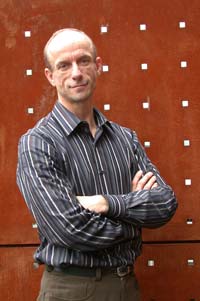 I have been fortunate over the years to have a number of terrific, smart, and helpful colleagues working with me. Significant among them have been Jack Crandall, John Haggerty, John Price, Marta Nojd Vinnedge, Matt Sellars, Ryan Vego, Matt Kramer, Jed Rauscher, Jim Wilcox, Eli Ridgway, Scott Lawrimore, Guy Merrill, Laura Komada, Josh McDonald, Carol Clifford, and Jena Scott. (Click here to see the current staff: Staff)
I have been fortunate over the years to have a number of terrific, smart, and helpful colleagues working with me. Significant among them have been Jack Crandall, John Haggerty, John Price, Marta Nojd Vinnedge, Matt Sellars, Ryan Vego, Matt Kramer, Jed Rauscher, Jim Wilcox, Eli Ridgway, Scott Lawrimore, Guy Merrill, Laura Komada, Josh McDonald, Carol Clifford, and Jena Scott. (Click here to see the current staff: Staff)
Now, as the gallery passes into middle age, I hope that it continues with the same promise with which it began. With eyes that remain fresh and a sensibility that regards contemporary art as the moving target it always is.
Best regards,
Greg Kucera

